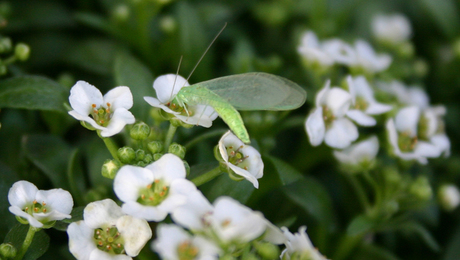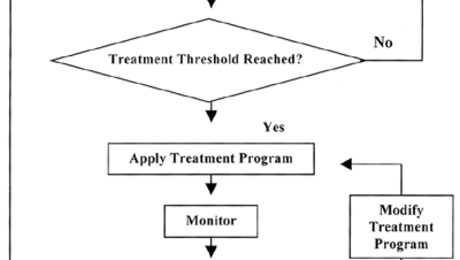Rusty Hawthorn
Not a person but a question on rust fungus on a Hawthorn. I was asked what to do about it during a chat and didn’t have the time to answer it fully. I believe the way the question was phrased that the person was asking “what can I spray to get rid of the rust”. Let’s look at it using the IPM Decision-Making Process.
Let’s do a little background first. Hawthorns (Crataegus spp.) are small trees or large shrubs in the rose family, rising to about 20′ to 30′ at maturity. They are often multi-stemmed and are native to North America and temperate forests of Europe, Asia, and Africa. There are over 100 species in the U.S., with some confusion in descriptions because the ease with which they hybridize. Leaf shape is variable, often within the same species. The flowers and fruit attract birds, bees, and butterflies. Foliage is often colorful in the fall. Flowers are very showy and usually white, they appear in the spring after the foliage. The branches and branchlets are thorny and can create a dense thicket. In fact Hawthorns are sometimes used as living fences as the thorns discourage all but the smallest animals and birds. Specimen plants need pruning to keep the water-sprouts and suckers at bay. Water-sprouts and suckers are more prone to insect and disease attack because of their “lush and tender” nature.
Insect pests are primarily aphids and scale. Hawthorns can be susceptible to fire blight, scab, powdery mildew, entomosporium leafspot, and of course rusts. Hawthorns often show resistance to one or more diseases at the species or cultivar level. When taken as a genus, Hawthorns are susceptible to about a dozen rust pathogen complexes. The three most common are Cedar-Hawthorn rust (Gymnosporangium globosum), Cedar-Apple rust (G. juniperi-virginianae), and Cedar-Quince rust (G. clavipes). As the name implies, these three disease complexes have alternate hosts. This means that rust fungus spores from a Hawthorn do not infect other Hawthorns, they infect red-cedars (junipers). It is the spore release from junipers, in one to two years following initial infection, that subsequently re-infect Hawthorns. The seriousness of the damage to the Hawthorn depends on which rust complex is affecting the tree.
Our first step is to find out exactly which rust fungus we have. Get samples of the leaves, fruit, and any affected twigs and take these to your local county Cooperative Extension Service (CES) office for a positive identification. It is courteous and helpful to call the CES office before you bring in a sample, they will tell you what to collect, how to package it, and when to bring it in for diagnosis. The CES may need to send the sample to the plant pathology department at your state’s land grant university, they are the headquarters for the CES in your state. To find your local CES office, enter your state’s name followed by Cooperative Extension on your search page. The web-search results will lead you to the homepage for the CES in your state, from there you can locate your county office. You can also look in your local phone book under County Offices for the listing.
Locate Focus Areas & Define Management Objectives:
· What is the purpose of the garden and how do we need to manage it to meet that purpose? [Is it strictly ornamental, primarily food, or a combination of the two?]
· Is the Hawthorn a focal point of the garden or is it part of a mixed species group of trees? [How visible is the individual tree in the overall garden? Is this a problem only you notice or do visitors to your garden notice the problem too?]
Monitoring:
· Is this a problem that you have year after year?
· Have you noticed (written down somewhere) if the disease is worse some years than others?
· What are the weather and environmental conditions like when the disease is a problem?
· Have you noticed signs of the disease locally on other trees in the rose family? (Apple, crabapples, quince, pears, mountain ash, etc.)
· Are there junipers (red-cedars) nearby?
Threshold- Set Injury Level and Treatment Threshold:
The first question here is extremely important!
· How much are you bothered by the disease symptoms?
· Depending on which rust disease is present, are the symptoms severe enough to affect the overall health of the tree or is this more an aesthetic problem?
· What plant parts are affected by the disease? Leaves, branchlets, fruit, two of these, or all three?
· The disease “severity predictor” for Hawthorns is the number of galls present on susceptible junipers and their spore production during the spring infectious period. Has wet spring weather helped the junipers produce lots of spores or has a dry spring left the galls dormant?
· Are susceptible junipers nearby? Can you monitor them?
· SPECIAL NOTE: This is the point in the IPM Decision-Making Process that you collect information on all of the treatment options for this particular disease. Really . . . collect all of them, even if you think you wouldn’t use one, write it down anyway. This is your “treatment action menu”.
Monitor:
· Look for susceptible junipers within a quarter mile, are there many, some or just a few?
· Look for rust symptoms on other trees in the rose family nearby, they will provide additional inoculum for the juniper cycle of the disease.
Treatment Threshold Reached?:
Keep in mind that “treatment” in IPM means any strategy or tactic that you use to manage or control a pest problem.
· For a Hawthorn, reaching the treatment threshold is primarily an aesthetic decision. (I’ve told people that leafspot problems on some of my own plants weren’t from a disease but that the leaves were “variegated”, and they bought it. In some cases, such as tulips, the variegations are the result of viruses, so technically. . .)
· Is the Hawthorn helping to perpetuate the disease cycle, by producing juniper infecting spores, that are affecting nearby fruit producing trees in the rose family?
· Is the tree declining over time? From season to season and year to year.
Apply Treatment Program:
Now we come to the tricky part, selecting just what we’re going to do here.
Cultural:
· Remove all susceptible junipers within one mile. (Not usually feasible. Most of the spores from junipers come from plants within about ¼ mile. Spores from junipers may travel over 15 miles to infect rose family trees.)
· Remove affected Hawthorn and replace with a species or cultivar that is resistant to rust diseases. (Be sure that if you select a rust resistant Hawthorn that it is not susceptible to one of the other diseases affecting Hawthorns.)
· Keep foliage and branches dry in the spring if this is possible. It will reduce the infection rate.
Physical & Mechanical:
· Prune out diseased plant parts on Hawthorn to reduce juniper infecting spores. (If there are other affected trees in the area this will not be effective. It can be effective in helping plant appearance for the season.)
· Prune out the galls on susceptible junipers before they produce spores during spring rains or irrigation.
· Remove the tree and replace it with a similar tree not in the rose family.
Biological:
· Currently no biologicals are known to control or prevent the three rust disease complexes discussed here.
Educational:
· Diagnose the disease. You need to be certain of the particular rust disease you are seeking to control.
· Using the scientific name given you with the disease diagnosis, search for information online.
· Knowledge is knowledge. It really doesn’t matter too much where the scientific information comes from, it can be adapted to your location.
· Can you live with the disease symptoms? If the disease fluctuates from year to year in severity, it may be that you can learn to live with it. An adjunct to this is to plant a resistant species/variety near the original Hawthorn. After a few years you can remove the susceptible Hawthorn and let the new tree grow into its own.
Least-Toxic Pesticides as a Last Resort:
The only recommendation that we saw falling into this category is the use of Sulfur as a fungicide. All other fungicides we felt didn’t fall into the “least-toxic” category, especially for an ornamental. All fungicides call for a minimum of 3 to 4 and a maximum of 10 to 12 applications of fungicide during the infectious stage. The differences in applications would be based on how long the wet, warm (45oF to 75oF) and windy spring weather lasts.
We consider multiple treatments to Hawthorns every year, even with Sulfur, to have too much potential negative impact on you, your family, pets, wildlife, and the garden plants and soil. We do not recommend treating Hawthorns or junipers for rust in garden situations. It is best to remove the tree and replace it with an unrelated species that has the same landscape value as the Hawthorn.
Monitor to Determine if your Treatment Program was Effective:
· If you chose a resistant species, how is it doing?
· If you removed infectious galls from junipers and cleaned up inoculum from the Hawthorn (that infects the junipers) has this lowered the level of infection to acceptable levels?
· You may have decided to “take no action at this time” and see if you can tolerate the situation. Has this worked for you?
Should Monitoring Continue?:
· Monitor again in the spring for signs of early infection and note the dates and weather conditions leading up to signs of infection.
· Monitor junipers in late summer for signs of galls, both old and new.
What We Would Recommend:
1. Leave it alone if you can tolerate the disease. There may be aesthetic damage but, depending on which rust you have, it may not be fatal. The disease may fluctuate from year to year helping to increase tolerance levels.
2. Remove the Hawthorn and replace it with a tree that is not in the rose family. Your local CES and/or Master Gardeners can make some recommendations on species that will do well in your area and have about the same mature size as a Hawthorn.
3. Remove the Hawthorn and replace it with a resistant species/variety of Hawthorn.
Conclusion:
We went through the Hawthorn rust problem as thoroughly as we could here using the IPM Decision-Making Process. Our options were fairly limited but our conclusion is to “design the pest problem out of the garden by removing the problem plant and replacing it with a more carefree species.”
Fine Gardening Recommended Products

A.M. Leonard Deluxe Soil Knife & Leather Sheath Combo
Fine Gardening receives a commission for items purchased through links on this site, including Amazon Associates and other affiliate advertising programs.


















Comments
Log in or create an account to post a comment.
Sign up Log in